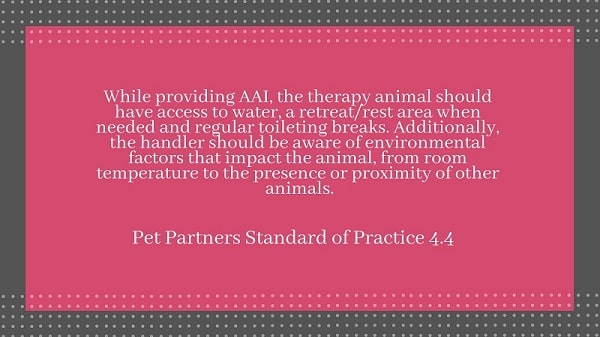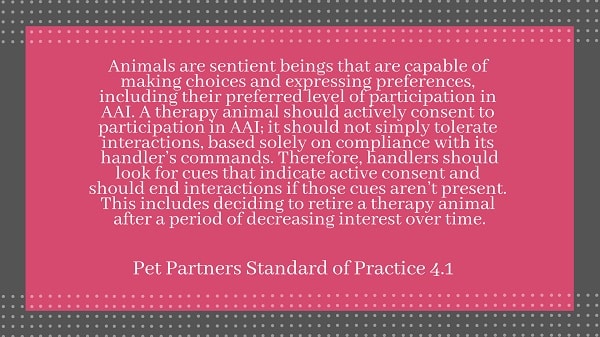



Therapy animal handlers enjoy volunteering their time to enhance the lives of others, but it’s important that therapy animals are also comfortable doing this work. Many people wonder whether or not therapy animals actually like their jobs. Two recent studies have addressed this question. A 2018 Applied Animal Behaviour Science study found that 26 therapy dogs working across various pediatric oncology settings did not show increased stress during their time spent working with patients, while a 2020 study by the Mayo Clinic-Rochester of 19 therapy dogs working with fibromyalgia patients demonstrated that there was no increase in physical signs of stress during visits. It’s reassuring to see evidence like this that therapy animals who have been screened and credentialed for appropriate temperament and aptitude can visit without negative impact on their welfare.
However, this research sparks a conversation about how crucial it is that we take appropriate steps to protect the mental health of our therapy animals. Here are ways you can protect the welfare of your therapy animal in a potentially stressful field.
To ensure that the mental health of our therapy animals is preserved, basic animal welfare considerations need to be paramount. These basic welfare considerations fall under the five freedoms for animals:
These five freedoms will be evident throughout our discussion of animal mental health, because without paying attention to these tenets, mental (as well as physical) health can be compromised.

Training with therapy animals should always be based upon a system of positive rewards, not negative punishments. As with humans, stress increases in animals during fear of negative punishments. Research has proven that dogs are more obedient when positive reinforcements are involved, and tend to “sour” when exposed to aversive conditioning. Beginning with a basis of positive training will contribute to the overall maintenance of your therapy animal’s mental health, as well as your bond, which is vital for a successful therapy animal team.
It’s very important that our therapy animals enjoy participating in animal-assisted interventions, not merely tolerate them. We support this so strongly that it’s codified in our standards of practice.

As part of supporting your animal’s mental health, periodically ask yourself some questions:
If you answer no to any of these questions, your animal may feel coerced into participating in therapy visits. Our animals should always enjoy their interactions with clients. It’s not uncommon for therapy animals who loved visiting early on to want to visit less as they get older, or to stop enjoying visits. If you notice changes in your animal’s responses to visiting, it may be in your pet’s best interest to decrease the number or frequency of visits, or retire the animal altogether.

There are many aspects of a visit that can be stressful to even the most well-trained therapy animal. Constant exposure to stressful situations can deteriorate a therapy animal’s health over time. Take a look at some of the ways you can tell your dog is stressed during a visit.
As a handler, you should be aware of the specifics of your animal’s body language. Perhaps your cat always crouches down with dilated pupils when he’s stressed, or your mini horse paws at the ground when she feels overwhelmed. Whatever your animal’s tell-tale stress signals are, always be sure to comfort your animal with PETS (Presence, Eye contact, Touch, Speech), or remove your animal from the situation and allow them time to fully recover.
Even though Pet Partners visits can be up to two hours per day, it’s always best to cut a visit short when your animal is stressed. Animals who are stressed during visits may be more likely to act out in negative ways and create an incident, which is bad for clients as well as for the animal. Regular rest breaks can alleviate the effects that stressful situations may have on a therapy animal.
It takes a special animal to be able to provide animal-assisted interventions, and it takes a special bond for these interventions to be safe and effective. You know better than anyone where your dog does or doesn’t want to be petted, what sounds your cat is afraid of, or the perfect way to approach your llama. Because animals can’t speak for themselves to tell us these things, it’s up to you as the handler to advocate for them (remember YAYABA™, You Are Your Animal’s Best Advocate) and to educate clients on the best way to interact with your therapy animal. This will cut down on unnecessary stress and minimize the possibility of incidents.

To date, a plethora of research has been published about how therapy animals impact the mental health of humans. However, there has not been much research done on the mental health of our therapy animals, especially outside of the realm of canines. Pet Partners began because our founders understood the importance of increasing the amount of research on the human-animal bond. Continuing in their footsteps and adding to the body of knowledge regarding the mental health of our therapy animals will help not only our therapy animals, but the advancement of our field as well.
If you have the opportunity to participate in a research study about therapy animals, consider taking part. You can also keep a journal of your therapy animal’s behavior and progress, to support their mental health and potentially provide more information to the field as a whole. Pet Partners registered handlers can record your visits through the Log a Visit feature in the Volunteer Center, which includes the option of telling a story or sharing specific details about visits. This is a great opportunity to include information about your therapy animal partner’s behavior and provide us with information about them over time.
Just as we expect ourselves to practice self-care and have work-life balance, the same opportunities should be afforded to our therapy animals. Make sure you allow your therapy animal to partake in their favorite activity, like swimming, playing with a favorite toy, or going on long runs. Homemade enrichment activities are another good way to ensure that your animal is properly stimulated, particularly for non-canine species who may have different needs for enrichment based on their natural behaviors. You can find great ideas for enrichment for your pet’s species by doing an internet search for “[species] enrichment”.
Pet Partners takes pride in being the gold standard of therapy animal registration programs. A large part of this is because we care so deeply about the welfare of our therapy animals. As with regular vet checkups and care for physical health, mental health requires the care and commitment of the handler. With ongoing conversation and consistent focus on the mental health of our therapy animals, we can continue to provide the gold standard of AAI to our clients and facilities.
How do you ensure that you take care of your therapy animal’s mental health? Feel free to contact us with ideas, resources, or questions.
The quoted panels in this post are taken from the Pet Partners publication, Standards of Practice in Animal-Assisted Interventions.
See the Pet Partners Position Statement on Animal Health and Welfare for an overview of our positions and best practice recommendations.